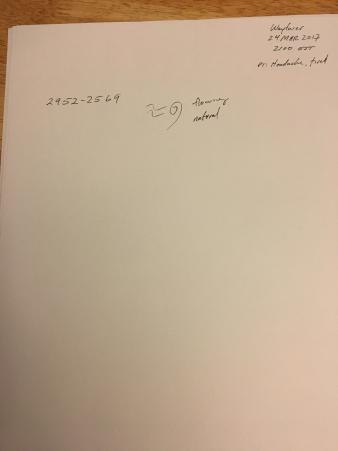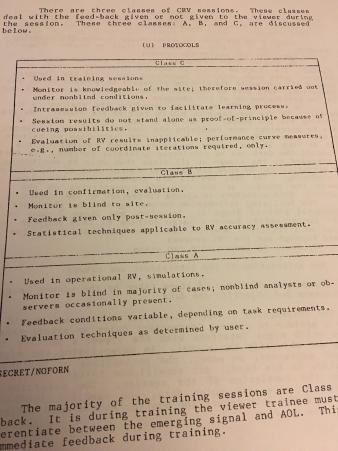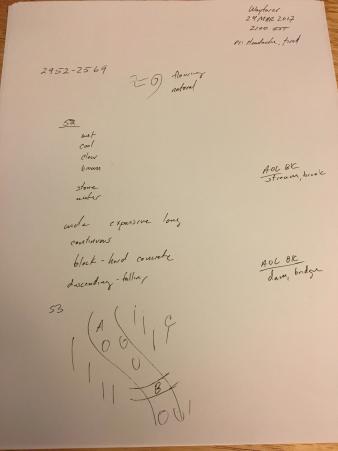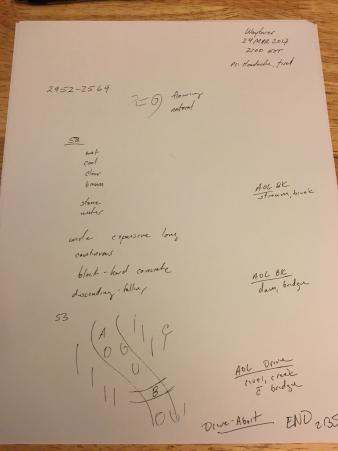Instructor: Rainsong & Wayfarer
Date: March 24, 2017 (Friday)
Note: This class was conducted in the Order of the Golden Pyramid community’s chatroom
Rainsong
Good evening, ladies and gentlemen.
Welcome to the third installment of the remote viewing class
As usual, Wayfarer is also instructing. *bows to Wayfarer*
Before proceeding, the obvious question is: is anyone interested in proceeding?
Shard
Was lucky enough to not have to work today, so I can finally make it here. 😀
Rainsong
Hi, Shard 😀
Have you read the previous two?
Shard
Yeah, not something I would do good at, but the knowledge has helped a ton in indirect ways. Thanks a ton for sharing, both of you.
Wayfarer
This is the one where we actually start doing some remote viewing, so it is the one to hit if you missed the first two I think.
Rainsong
Glad it’s proving useful, even indirectly. And you’re welcome.
Shard
Wondering where everyone else is… I figured this was a popular topic.
Rainsong
It had been
Wayfarer
Activity dropped off a bit after week 2 despite week 1 seemed rather popular. Might be the text lecture effect where people figure they can read back?
Rainsong
Maybe? Or perhaps it turned out not to be as interesting to them as they thought it would be.
Shard
I suppose that is true, part of why I like text-based.
Dr. Strange Stuff
I am here :]
Rainsong
Hi, DSS
Dr. Strange Stuff
Hello
Rainsong
Last week, we talked about ideograms, and Stage 1 a bit.
Today, we’re going to get into the mechanics of doing a remote viewing session…at least to Stage 2.
(Yes, there are several stages, and each is added sequentially, after practicing the previous stages for a while…
…and by “a while”, I mean weeks.
…Or months)
So, we’re not actually expecting anyone to be ready to do Stage 2 yet.
Wayfarer
Fortunately Stage 2 is the beginning of operationality and stages 4-6 are iterations on stage 3, so competency can be gained quickly with diligent practice.
Rainsong
Indeed. But don’t skimp on practice at the first and second stage levels, if you have any desire to be at all good at it.
Are there any questions arising from the previous two classes, or what we’ve just said, before we continue?
Dr. Strange Stuff
Nope
Shard
No questions here either.
Rainsong
Alrighty then.
As you know, before you start the “viewing” part of remote viewing, there needs to be something to “view”.
So, I’m going to tuck “Tasking” in here.
As the name suggests, “Tasking” is the act of setting up the “task” or determining what the target is and relaying that assignment appropriately.
Usually, the target is relayed as a set of numeric or alpha-numeric “coordinates” that are assigned by the tasker.
The coordinates are associated with the actual target by the tasker’s intention.
The target *itself* is described by a photograph, or a brief description, or sometimes a question.
For example, a photograph might be set in an envelope, with the numbers 1435-6837 on the outside. The viewer would be told the numbers.
Or the photo might be on a website, such as the Target Monkey site I posted earlier in the week
http://www.remoteviewed.com/target/
Wayfarer
As a theoretical note, the working hypothesis on coordinates is that remote viewing works by contacting a kind of “informational matrix,” a kind of “set of all information.” When the tasker assigns a coordinate the coordinate becomes associated with the target as “information about the target” and this creates the link to the target.
That’s purely a hypothetical based on Ingo Swann’s philosophy, and at the end of the day it isn’t really important. It just works.
Shard
Honestly, the important part is it working. Don’t need to know about gravity to stay on the ground, after all. It is nice to know, but not vital.
Wayfarer
Right. Some people go “wait – how does a random coordinate refer to a discrete thing” and the informational matrix hypothesis accounts for it. It’s included just for those people who might wonder.
Rainsong
(For written descriptions, take an index card or sheet of paper, and write something like “6346-2356 / Enfield, NS / 14 April 2016 / name of winner of first race of the evening” )
(or even “5435-2347 / Describe the interior of the basement of the building at 1549 Young Street in Ontario”)
(Or, for ARV purposes – ARV will be explained in a later class – “Describe the photo that will be shown to you at 1634hrs on May 14, 2017”)
Wayfarer
It is possible to task your own sessions but not for time-sensitive targets. We can discuss the file-folder of envelopes at some point later during the night I think, after we discuss stage 2.
Rainsong
Or now, if you prefer?
Dr. Strange Stuff
Sure
Shard
No preference here, I’m just here to learn what is shared. DSS?
Dr. Strange Stuff
:]
Rainsong
Wayfarer’s right that it will probably fit better later, but I want to be sure it gets in here…
It’s important to avoid knowing what the target is that you’re viewing, for reasons discussed in a previous class.
That makes tasking yourself a bit tricky.
But there’s a way around it.
(And it’s really obvious, if you stop and think about it)
Nip over to the nearest el-cheapo everything-for-a-dollar store and purchase a box of envelopes. Fifty or a hundred envelopes,
…and package of index cards or a small notepad
Start a collection of pictures: clip bits out of junk mail, print off pictures from the Internet… and assign them coordinates.
One picture and coordinate per envelope.
On the cards or papers, start a collection of “things to ask about”:
“Describe the interior of the drawer under the oven”, ”(date)/location/ (name of race)/name of winning horse“
Things like that.
Eventually, you’ll have quite a collection.
When you have a task you want to assign yourself, write it in the same way.
Pull out five or six other targets, and shuffle the envelopes together.
Run those six or seven sessions.
Wayfarer
(Not all at the same time, mind)
Rainsong
You can see where that is going… and why it’s not so great for time-sensitive targets, yea?
Separate sessions by at least half an hour, by the way… and don’t drive if you’ve done more than one that day.
Wayfarer: anything I’m overlooking there?
Wayfarer
Nope that’s more or less how it’s done. I usually assign the coordinates by putting coordinates on the envelopes first, then targets into the envelopes at random. It’s important to not know what the target is before viewing it, for what should be obvious reasons.
Rainsong
Of course, if you can trade collections with someone else, so much the better.
Wayfarer
Or, ideally, by having someone else set up the session.
Right.
Rainsong
Questions, before we continue?
Dr. Strange Stuff
“Don’t drive if you’ve done more than one that day”?
Why is this?
Shard
Not a question, but an idea based on what Wayfarer said – use labels with the coordinates printed out, stuff things into envelopes, shuffle them, then slap labels on. Be even more unknown that way with minimal added effort.
Rainsong
DSS: There’s a risk of your “consciousness” going back into “viewing mode” and not being entirely aware of the road. The American military guys were not allowed to drive on days when they did more than one session… so it’s probably smart to follow the same rule.
Shard: good idea. All you’d need is a clear intention of ”(this coordinate“) is connected to the picture/description contained in this envelope”
Dr. Strange Stuff
:thumbsup:
Wayfarer
Yeah, Shard, that’s more or less how it’s done. In either case you shouldn’t ever know what target is going into what envelope and so on if you’re doing it that way.
Rainsong
Alright. Looks like we’re ready for the next bit.
We’ll pretend we have a nice, friendly target. We’ll call it 2952-2569.
And we’ll presume you’re sitting comfortably at a desk or table, with a stack of letter-sized or A4 white paper – the kind you’d use in a photocopier or printer – and a black pen whose ink flows freely (not one of the crappy ball-points).
Wayfarer
Would you like I set up a blank session sheet as one would for an example? I can upload a photo directly in here.
Rainsong
That’d be lovely, Wayfarer. Probably easier to follow than a description of it alone
While he’s doing that…
Before you start your actual viewy-stuff, you’ll want to calm and quiet your mind. Meditation’s one way to do it. Running your hands along your meridians is another.
Grounding and centering, along with a nice field-cleaning, are also good.
The idea there is to get rid of the most obvious distracty bits. (Which is part of -and only part of -the reason that running a session while on a ladder in a cafeteria was …not good protocol)
Wayfarer
How far do you want and are these coordinates assigned so I should run it or…? Actually I can move forward as we go and just fill it in as we proceed.
Wayfarer
Page setup as of coordinate assignment prior to stage 1

Is that legible to people clicking? I can reposition the light for the next photo.
Rainsong
Thanks 😀
Legible from here
Wayfarer
(Page setup is flexible. This is how I prefer to do it, there are other ways. The vital information are the viewer, the time and date, the monitor if there is one, and personal inclemencies.)
Personal inclemencies (seen here to be headache, tired) are things that might adversely affect the session.
Basically anything that might fuck you up. Remember that this was developed for intelligence purposes and that sometimes targets are time sensitive. If the viewer is having a bad day you can’t always wait for them to get sorted.
So you just document that the guy is having a shitty day and roll with it, taking into account that he might be garbozone due to whatever.
Rainsong
Or that some of the “data” might be from the inclemency.
Wayfarer
This also helps for developing a routine because if you always wait to view until you’re feeling 100% great, you will basically never do a session.
Rainsong
For example, if the room is uncomfortably hot, there may be extraneous “heat”-related data that’s not from the site.
Shard
Sorry, forgot to respond earlier, yes it is legible.
Wayfarer
Okay. Also, so I know, Rainsong, is this a hot target or should I just put some random stuff in for the Stage 1 and 2 impressions?
Rainsong
It had been a random set of numbers, but I’ve attached a target to it. Therefore, you can go either way on it. Your choice.
Dr. Strange Stuff
(I had to step away but I am caught up and back.)
Rainsong
The next bit is to set your pen on the paper beside the target number and focus on “Ideogram”… let the pen move. Don’t watch it.
As soon as the ideogram is done, move your pen lower on the page, a bit below the target number, and write “A.”
Place the pen on the page below “A” and think “A?”….
….and for this section your subconscious is querying motion. Go ahead and think “motion?”
Write whatever comes to mind.
Adjectives are what we’re really going for here, but don’t edit out anything.
Wayfarer
This is gonna be a rough session but I’m proceeding as if it’s a session. I didn’t prep and my wife just started talking to me in the middle of IAB, but hey maybe something neat will come of it.
Rainsong
Understood. Not to worry.
As discussed previously, if you have a guess as to what the target is, or if you see or hear a coherent picture at this point; Write “AOL” at the right side of the page, and write the description of the guess or picture under it.
Wayfarer
Composite ideogram with gestalt

Rainsong
Then put your pen down for a few seconds.
After the few seconds, go re-orient to the target by poking either the ideogram or the target number (some prefer one, some prefer the other.,.. I believe the official way is to poke the ideogram) and think “Motion?” again… and continue to describe.
(correct gestalt, by the way)
Wayfarer
Usually if you have AOL from the Stage 1 A component I would abort and readdress later – you’re way off structure at that point. Stage 1 is a quick impression, just snap judgement of what you’re looking at and what the kind of movement of the location is. AOL can happen here but I’d be extremely wary.
Rainsong
I’m not a skillful monitor… but if we were doing this right, for much of the description, as monitor I’d let Wayfarer know that data is correct by saying “correct”… If something is incorrect, there is no feedback given. And there are a couple other options such as “probably correct” and “no feedback possible”….
In any case, staying within the proper structures and protocols is *more important* than getting correct data.
I know that’s strange, but it’s true.
Wayfarer
We are doing a class C session.

Rainsong
For operational stuff, you don’t want the monitor knowing the target because the viewer can pick up telepathic data from the monitor, thus mucking up the information.
This is known as “Telepathic Overlay”
Wayfarer
Acceptable feedback in a Class C session is:
Site (S) – you hit the target, job done.
Correct (C) – information is correct, but you don’t have enough information to confirm you have site.
Probably Correct (PC) – it’s probably right based on what the monitor knows of the target, but can’t be sure.
Near (N) – you’re not on the target but you’re looking at things around the target.
Can’t Feedback (CFB) – no way to know if it’s right or wrong due to limited information.
As Rainsong said, during training sessions you do not give negative feedback. If something is wrong, you just don’t give positive feedback. This helps train the viewer to differentiate signal from noise without encouraging them to guess at things.
Rainsong
Wayfarer and I had different instructors, and were taught slightly different layouts. The important stuff is the same, though.
I say that because I’d have put the flowy and natural bits under the ideogram, instead of beside it. Both conventions are fine, though.
Wayfarer
Oh, huh. Yeah I was taught ideogram then AB data in that kind of triangle format. Those ideograms are compromised my wife started talking just as I was drawing it.
(I had told her I wasn’t running a session but – welp – changed my mind)
Rainsong
The B bit is “Feeling?”
And in this case was “natural”
Wayfarer
The B is overall gestalt. The general impression of the site. “In a word. . . ?” or “Feeling?” yeah.
I don’t like to ask “feeling” because I consider that S2 (sensory) information but it’s semantics.
Rainsong
*nods*
Are you up to continuing, Wayfarer?
Wayfarer
I’m in Stage 2 now.
I’ll go ahead and run to 3 just so I can call it a short session but I won’t unpack into 4, that way they can know where they’re going at least.
Dr. Strange Stuff
😀 Thanks.
Rainsong
In stage 2, you add “sensory data”, as he mentioned. These are descriptors that might be visual, sound, hardness, temperature, and so on.
This is where you’re likely to have AOL happen. In fact, in a regular session, if you do *not* have any AOL, your session’s almost certainly garbage.
Wayfarer

And actually in fact
Rainsong
C, c, c, c, pc,
c.c.c.
Wayfarer

Rainsong
cfb
cfb
cfb
Wayfarer
Haha, a lot of Cs there, hate to call that, but I’m driving on the river thing and since we’re already on 3 and I’m not moving onto the next stages for this target I ended.
Rainsong
s3 – some correct, and some N… some cfb
*nods*
Wayfarer
AOL is good. AOL is what your brain does with raw information, it’s pattern matching, it’s what human brains do. When you AOL you declare a break and put your thing on the paper to get it out of your head. You *should* then take as long as you need to shake that and then readdress the target using the coordinates or the ideogram.
AOL *Drive* is bad.
Rainsong
Initial data was very good… stage 3 went to the AOL… hardly surprising in this situation.
Wayfarer
AOL Driving, sometimes called peacocking, is when your brain has gone after the drive.
There’s a pond in the mix here somewhere too or a lake.
Maybe like a moving fountain thing.
Rainsong
It’s called “peacocking” because your imagination unfolds new bits of imaginary data like a peacock gradually unfurling his display feathers.
Wayfarer
(This is where I do a thing where I start calling data after I’ve ended then kick myself for hitting the target but not documenting.)
Rainsong
Should I put the target in here?
Wayfarer
Sure, lots of PI on this and I’m not too ashamed if it’s a miss, they can see how S2 data relates and so on.
Rainsong
The target is “Describe the contents of the primary picture on this webpage: https://www.allaboutbirds.org/guide/Royal_Tern/lifehistory
Wayfarer
I’d rather they see me hit a target first but I mean that’s the nature of the sport. lmao
Miss.
But I did that thing I do, so it’s probably okay.
Rainsong
Structure was good. And the Stage 1 and the first section of Stage 2 have good data.
Wayfarer
(Everyone think waaaaay back to the first teaching session, remember how I mentioned people kind of get attuned to certain things? I tend to hit locations and I suffer hard with pictures)
Rainsong
And that’s my mistake. I should have assigned a target more appropriate for his strengths.
Wayfarer
Structure is more important than information, though, is the key point here. Because the structure remained intact the session is valid and provides useful information. The presence of water, stones, etc., were all there.
Dr. Strange Stuff
Wow, this is amazing.
Wayfarer
Eh, I should’ve run the session correctly.
Rainsong
SDD: You should have seen the time he drew a map of downtown Ottawa….
Shard
That itself is a good point that needs to be hit more often – when working with others, aim to make use of each person’s strengths. Too many times I see talk of working as a group and it ends up with everyone being crammed into things they suck at.
Wayfarer
I have a problem with temporality in sessions. If I don’t prep for a session adequately (I am literally drinking a coke while sitting in a way suboptimal chair with a lot of inclemencies here) I tend to have a hard time going to the target-as-intended and instead I go to the *place* at the *current time*.
If we’d been doing a more formal session and I’d known I was going to view tonight I might’ve stood a better chance. I also have a really hard time with people/animal targets generally, because they kinda come in hazy to me. I would reckon that Tern was hanging out by a coastal abutment near an inlet or outlet, but there’s no way to be sure since it’s a photo.
Rainsong
Given where Royal Terns live, that’s almost certainly the case.
Wayfarer
She says seashore with surfers around so I would imagine the elements are there but I peacocked the S3 data hard.
Eh. I could’ve done better.
Rainsong
I chose the target in terms of “Oh S#it…what can I find and link to?” while trying to stay coherent in here *and* answer an urgent email from a client…. And I’d been looking up the winter plumage of terns earlier today.
Wayfarer
lmao
Anyways that’s neither here nor there, the elements of the structure are the important thing.
Rainsong
And it was a good demonstration. Thanks for going out on the proverbial limb there.
Wayfarer
I decided to view rather than just mock it up because I can fill out a runsheet with correct structure when I’m just running rather than trying to think about it. That’s how you want to be. The structure serves to keep us busy with mechanics to prevent interfering with signal line information.
It also serves to prioritize the information and organize it in a consistent way.
That consistency helps a lot at learning to tell good information from bad.
Shard
*nods* It was certainly interesting to watch, and surprisingly accurate. I absolutely cannot manage that sort of thing at present, so it is very nice seeing that it does work, and being able to learn from it.
Wayfarer
In this case I got a lot of good information, and no bad information, but not the *right* information. It’s definitely a Miss, but Misses can be *useable*. This could provide actionable intelligence if taken in conjunction with other information (say the tasker wants information on a bird, I’ve given information that could confirm it is a water bird, or at least that it would be worth looking around water.)
Dr. Strange Stuff
Yea this whole process is astonishing, I really look forward to learning how to implement this and use it effectively.
Wayfarer
I can monitor some practice sessions moving forward if people would like. The best way to learn structure is to do it, so maybe a companion practice night to the lecture night is in order?
Shard
Aye, the large picture isn’t always wrong just because smaller details are off. It is part of what I find so interesting with RV, you can learn quite a bit even with various degrees of inaccuracy, because the method is based around continual bits of info instead of “Here, what is this?” – a very different method than what I have encountered in the past.
Rainsong
And the ARV I mentioned a few times only needs a relatively small amount of the basic data, in order to be useful. But, again, we’ll get into that in a later session.
Dr. Strange Stuff
I really like the idea of someone with experience overwatching us practice.
Wayfarer
Yeah. One of the strengths but also the weaknesses of, for example, “shapes and colors” is that you are distinctly right or wrong. But so much of this psychic stuff has so much room for an in-between. I have been just *wrong* sometimes with RV, but generally I at least have the S2 information correct. I have a bad habit of blowing my S3 on an AOL drive.
Serrena
You are welcome to schedule practice days/nights in the psionicdojo.
Wayfarer
And for example with ARV, since the basics have been mentioned before, let’s pretend this was an ARV session, and that target coordinate had been assigned to “will Pfizer stock go up tomorrow or go down?”
Let’s say that that target that I ran was “up”
And this was “down”:

Dr. Strange Stuff
Wow, now you are taking a good idea and lathering it in gold… You have my attention, Wayfarer :heart_eyes:
Rainsong
(Or an even better down would be the Great Pyramid of Giza)
Wayfarer
It doesn’t matter that I blew stage 3, because the information from stage 2 is more than enough for the tasker to take a quick look and go “okay buy.”
Right
That
Rainsong
Exactly.
Wayfarer
Because this is still biologic/organic.
If the down was the Great Pyramid we’d be able to tell from Stage 1.
Gestalt – natural. Boom, up. Gestalt – manmade. Boom, down. Done.
Dr. Strange Stuff
How specific can you get with the questions?
Wayfarer
For ARV? Fairly specific, it does best with multiple choice answers.
Rainsong
I took a refresher course in one of the protocols lately, and the instructor for it uses it to determine the name of the horse that will win the next race.
(in a specific track, obviously….)
Wayfarer
Discrete yes or no, ‘which one of . . . ‘ etc. both work for ARV. I’m by no means an ARV expert because one of my teachers had some strongly held ideas about it that I sort of inherited, but it’s very useful for that kind of thing.
Rainsong
Actually, funny story about “not being specific enough…”
Duck-banding for the Canadian Wildlife Service…. my boss and I decided, on a lark, to dowse to figure the number of ducks we’d “get” the next day….
What we wanted was the number of ducks we’d put bands on and record.
What we got was the number of ducks we’d catch. Several were already banded.
Be careful about how you phrase things, because the same errors will happen in RV tasking as in dowsing.
Wayfarer
Incidentally, viewers often make shitty taskers.
I tend to phrase targets either way too ambiguously or way too precisely because my experience of RV is from this side of the table.
I also tend to not task things I don’t think I personally would be able to hit but that’s just a bit of pride. lmao
With straight RV though it is important to know its limitations a bit. It’s unreasonable to task a conventional CRV viewer with “the fifth word on the second paragraph on page 3 of the document in the briefcase” or whatever.
It’s viable, but requires some special training, to do something like “the topic of the paper in the briefcase.”
Rainsong
And a lot of people have trouble getting numbers in standard RV. It can be done, but it’s not the optimal use of the approach.
Wayfarer
Yeah numbers and letters are both tricky things. Numbers are usually best kept to standard descriptive quantifiers. “A few,” “a lot,” “some,” “many,” “one”
There are “a bunch of trees” not “there are four trees.”
(…and ideally “several long tall solid brown green rising”)
Rainsong
And “the combination for the upper lock on the safe in the wardroom of USS Dallas” is even less workable.
Wayfarer
So yeah, tomorrow evening I am busy but Sunday evening maybe I will run some Class C RV sessions. We can do it either with photo or typed feedback or on vocomms.
Rainsong
That’s an excellent idea. 😀
Are there any questions or comments about what we covered tonight?
Dr. Strange Stuff
I am just sitting here trying to absorb it all still. haha
Thank you both very much for your classes so far and I hope to work with you in the future in RV.
Wayfarer
It’s a very jargon-heavy field and doesn’t lend itself well to kind of simplifying the language, so I apologize if it’s super dense. But I’m happy to be tagging along to help where I can here and I’ll be happy to monitor some sessions moving forward.
Rainsong
Thank you for participating, all of you. And thanks for co-teaching with me, Wayfarer 😀
Shard
Thank you both for teaching it. I may not use it directly, but there is a lot of value to learn regardless. 😀
Rainsong
😀
In your case, it may be worthwhile to give it a shot sometime… Just a practice target, nothing that you need to worry about.
Shard
I fully intend to try it fully once I am less… Incompatible?
Wayfarer
After we’re done teaching RV as such, we can have a nice chat about how applying the protocol system to this kind of thing can be used for other generically psychic pursuits and so on. And yeah, I would suggest trying to run it. I don’t know your specifics but you’re a person with paper and a pen, with a good monitor you should be able to try it regardless.
Shard
It is just that at present I am way too screwed up to do well at it. Once I fix me, then I can get started on stuff that is more direct. I can’t ask a construct of mine to go RV for me. Lol
Wayfarer
For now it’s better we not mix up protocoling into other things as that gets confusing fast.
Well, I would suggest you don’t need to do that and I’d like to see how a session goes regardless. I just missed on the first demo target so the bar ain’t particularly high here. lmao
